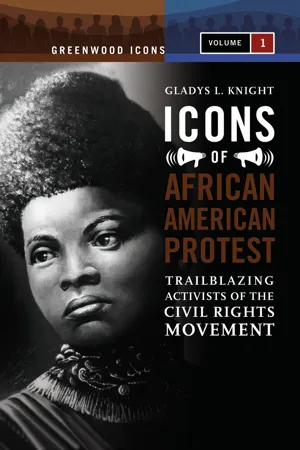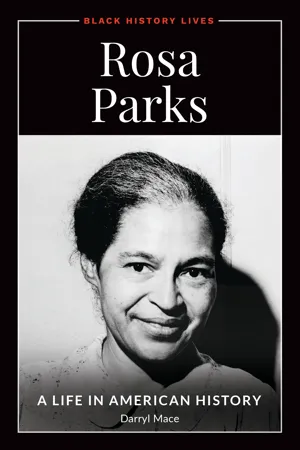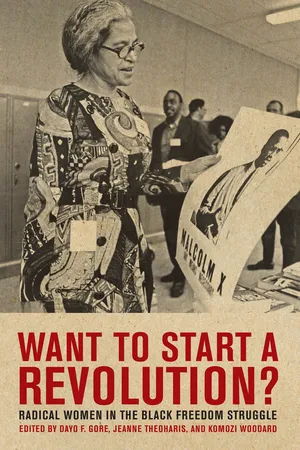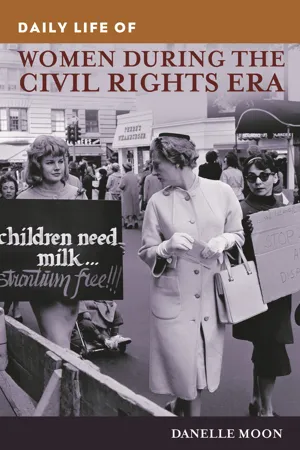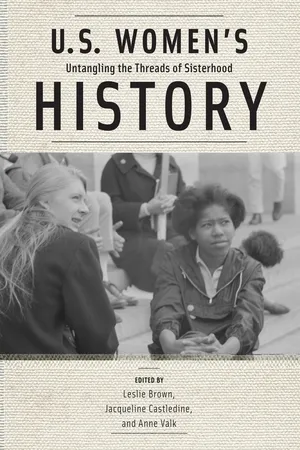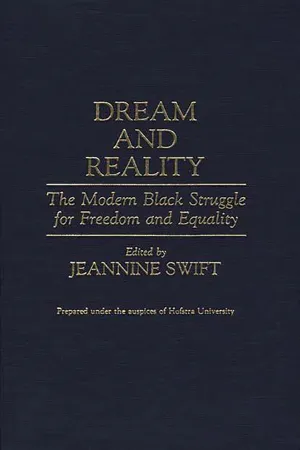History
Rosa Parks
Rosa Parks was an African American civil rights activist known for her pivotal role in the Montgomery Bus Boycott. On December 1, 1955, she refused to give up her seat to a white passenger on a segregated bus, sparking a major turning point in the civil rights movement. Her act of defiance and the subsequent boycott led to significant advancements in the fight against racial segregation.
Written by Perlego with AI-assistance
Related key terms
1 of 5
12 Key excerpts on "Rosa Parks"
- eBook - PDF
Icons of African American Protest
Trailblazing Activists of the Civil Rights Movement [2 volumes]
- Gladys L. Knight(Author)
- 2008(Publication Date)
- Greenwood(Publisher)
Rosa Parks (1913–2005) Library of Congress Rosa Parks was a domestic worker, seamstress, and activist. She is most known—and indeed celebrated—for a single and spontaneous act of protest, when, on December 1, 1955, she refused to give up her seat to a white pas- senger on a public bus in Montgomery, Alabama. Parks was an unlikely and unassuming hero. She was only forty-two when she was arrested for violating Alabama state law, but she appeared almost grandmotherly, with her trademark hair pinned neatly back and a pensive, strained expression on her bespectacled face. Even to those who knew her, Parks was quiet, reserved, soft-spoken, and timid. To the white community, she was invisible amongst the droves of African American women plodding back and forth from home—the black side of town—to a long day of clean- ing, laundering, and other menial work for white employers in the white section of town. No, Parks was neither a notorious troublemaker nor a charismatic rebel leader. And yet beneath her mild-mannered demeanor there lurked a revolutionary. Parks was a secretary of the local chapter of the National Association for the Advancement of Colored People (NAACP), a devoted member of the African American Methodist Church, and the wife of an activist. That day when Parks refused to give up her seat to a white passenger and told the white bus driver ‘‘no’’ when he ordered her to do so, though she risked violence or worse, was not her first act of protest against racism. Even as a fragile and sickly child Rosa had fought back—sometimes ver- bally and other times physically—against racial attacks. That day did not even mark her first incident on a racially segregated bus. What was different this time was that her act of resistance on that day in December would launch her from obscurity to instant fame as a protest icon and give impetus to a massive bus boycott led by a young Baptist minister by the name of Dr. - eBook - ePub
Seven Women
And the Secret of Their Greatness
- Eric Metaxas(Author)
- 2015(Publication Date)
- Zondervan(Publisher)
SIX Rosa Parks 1913–2005I f you have heard of Rosa Parks, you know that this famous woman entered the history books for refusing to give up her seat on a bus. This simple act launched the now-historic yearlong Montgomery bus boycott, which in turn catapulted Martin Luther King Jr. to fame and effectively set in motion the Civil Rights movement. For this reason, Rosa Parks is rightly remembered as the “Mother of the Civil Rights Movement.”But just how did this humble, dignified woman come to be the focal point of this period in American history? And what became of her after that fateful day on that bus? This is her story.R osa McCauley was born in Tuskegee, Alabama, on February 4, 1913, to Leona Edwards McCauley, a schoolteacher, and James McCauley, a carpenter and stonemason.For Rosa and for most blacks at that time, faith and the church were at the center of life. The church was a welcome, life-filled refuge from the bitterness of that time and place, one known for the lynching and burning of innocent blacks for their alleged crimes against white people. From her earliest years, Rosa loved the words and music of the church. Throughout her life, she attended the African Methodist Episcopal Church.“Daily devotions played an important part in my childhood,” she said. “Every day before supper, and before we went to services on Sundays, my grandmother would read the Bible to me, and my grandfather would pray. . . . I remember finding such comfort and peace while reading the Bible. Its teachings became a way of life and helped me in dealing with my day-to-day problems.”1But the Bible had a social mandate in its message too, one that taught Rosa that “people should stand up for rights, just as the children of Israel stood up to the Pharaoh.”2 - eBook - ePub
The Possibility of Contemporary Prophetic Acts
From Jeremiah to Rosa Parks and Martin Luther King, Jr.
- Bush(Author)
- 2013(Publication Date)
- Pickwick Publications(Publisher)
The historical and anecdotal evidence associated with Rosa Parks’s act suggests that it can be evaluated positively in regards to all four of these categories. The act of refusing to move from her bus seat definitely caught the attention of the bus driver and all the other passengers, both in terms of the nature and quality of Parks’s civil disobedience. For example, when James Blake threatened Parks with being arrested, her measured response was “You may do that.” This identified her not as a passive victim but as an active protester of the bus segregation laws. That the severity of the act was readily apparent and easily comprehended is seen in how Blake immediately called for two policemen to come and arrest Parks. According to testimony gathered later, the witnesses to Parks’s self-possessed act sat in stunned, silent recognition that this time the authorities had picked the wrong woman to mess with. 138 These same witnesses were able to provide accurate descriptions of what transpired that day, enabling a broad retention of the details and facts associated with this event. Lastly, the widespread reaction to Parks’s arrest, especially among those who personally knew her, was one of anger, frustration, and a renewed commitment to work for change, so that such painful incidents would not happen again in their community. Is it possible to speak about what Tillich calls a kairos moment occurring on that December day? In remembering Parks’s historic act, one recurrent question is whether or not it was planned or premeditated. Douglas Brinkley, Parks’s biographer, answers with a clear “No.” As he puts it, a “lifetime’s education in injustice—from her grandfather’s nightly vigils to the murder of Emmett Till—had strengthened her resolve to act when the time came.” 139 Martin Luther King, Jr - eBook - ePub
Rosa Parks
A Life in American History
- Darryl Mace(Author)
- 2021(Publication Date)
- ABC-CLIO(Publisher)
Why does Rosa Parks matter? She matters because her life is a moving example of the life of black Americans. Born in a town that held the promise of racial uplift, Parks’s life showed the harsh reality of African American lives. She learned how to stand up for herself, how to stay alive, and the importance of education in the process of black uplift during her formative years; and she carried those lessons into adulthood. Rosa Parks, like many other black people focused on racial justice, surrounded herself with positive activists who wanted to bring about social change. She worked tirelessly, despite limitations placed on her by her gender and the gender roles of U.S. society, to see racial justice. Rosa Parks directed her efforts in support of black institutions and organizations bent on racial uplift, and she did what she could within the confines of gender norms to push for equality. Understanding the crucial nature of education, Rosa Parks worked with youth in Montgomery, and she educated herself in many ways, including her voracious reading habits and her time at Highlander Folk School. When it came time for Rosa Parks to take a stand in protection of her civil and corporal rights, she did so without hesitation. From her first refusal to give up her seat on the segregated buses in 1943 through her arrest in 1955 for violating segregation laws, Rosa Parks was in control of her person, because she knew that in white supremacist America, her civil rights depended on her corporal rights. After her arrest, Parks worked within the spaces afforded women to raise money and support for the Montgomery Bus Boycott, and she continued to support mass organizing efforts on the part of organizations like the MIA and the NAACP. Rosa Parks joined other black protestors in moving away from oppressive conditions in the South. While conditions in the North often mirrored those in the South, Rosa knew that removing herself from Montgomery was a way of taking control of her body and forwarding her black protest initiatives. In Detroit, she continued to work with activists on black protest efforts, in that city and around the country. Connecting with the plight of blacks in South Africa, Rosa lent her efforts to battling apartheid in that African nation.Rosa Parks matters because hers is a story of civil rights and black protest regionally, nationally, and internationally. She matters because studying her life illuminates the cultures of gender, white supremacy, and black protest that are at the heart of the American narrative. Her story matters precisely because it is not a fable of the American dream. Rather than a fanciful American dream narrative, like the rest of black Americans, Rosa Louise Parks’s story is the story of the reality of black life in America. - eBook - ePub
The Civil Rights Movement
A Documentary Reader
- John A. Kirk(Author)
- 2020(Publication Date)
- Wiley-Blackwell(Publisher)
Chapter 3 The Montgomery Bus Boycott and the Southern Christian Leadership Conference, 1955–73.1 Rosa Parks Recalls Her Role in the Montgomery Bus Boycott in 1955
Rosa Parks’s arrest aboard a Montgomery bus on 1 December 1955 has become an iconic moment in the civil rights movement. Interpretations of what that event means have changed significantly over time. Early representations of Parks’s actions, notably in Martin Luther King, Jr’s account of the bus boycott, Stride Toward Freedom (Harper & Row, 1958), portrayed Parks as a tired seamstress who spontaneously decided to defy segregation laws because her feet hurt. This was part of a conscious attempt at the time to depoliticize Parks’s actions and to instead emphasize the human element of the bus boycott, not least to avoid the common charge of communist‐inspired agitation against activists that was prevalent in the wake of Sen. Joseph McCarthy’s anticommunist crusades that had gripped the nation.More recently historians have become aware of Parks’s longstanding commitment to racial and social justice struggles. Before making her protest, Parks had been the secretary in the local Montgomery National Association for the Advancement of Colored People (NAACP) branch, she had attended classes in social justice at Highlander Folk School in Tennessee, and she had been involved in women’s issues, including investigations into the rape of black women by white men. Parks was well connected to activist networks in the local black and white communities. While her actions on 1 December do not appear to have been part of any formally preconceived plan to trigger a bus boycott, Parks made a politically conscious and informed choice in the context of decades of personal activism to defy segregation law on a Montgomery bus.When I got off from work that evening of December 1, I went to Court Square as usual to catch the Cleveland Avenue bus home. I didn’t look to see who was driving when I got on, and by the time I recognized him, I had already paid my fare. It was the same driver who had put me off the bus back in 1943, twelve years earlier. He was still tall and heavy, with red, rough‐looking skin. And he was still mean‐looking. I didn’t know if he had been on that route before – they switched the drivers around sometimes. I do know that most of the time if I saw him on a bus, I wouldn’t get on it. - eBook - PDF
The Civil Rights Movement
Struggle and Resistance
- William Riches(Author)
- 2017(Publication Date)
- Bloomsbury Academic(Publisher)
31 2 Grass-Roots Struggle in the South: 1954–1959 It was on Thursday, 1 December 1955 that the 42-year-old Mrs Rosa Parks, who inspired the young Melba Pattillo, was arrested. Returning home from her day’s work as tailor’s assistant in a Montgomery, Alabama department store, she took her seat on the bus and a white man was left standing. The driver ordered her to move because a city ordinance did not allow a black person to sit parallel with a white passenger. Mrs Parks refused. Three times she was ordered to move and she said ‘No’. Warned that she would be arrested, she told him to go ahead. He called the police and she was taken to jail. These events sparked the Montgomery bus boycott (Garrow, 1988 ) and no one involved realised that this was the first step in the massive struggle of African Americans to overthrow the so-called ‘southern way of life’. Mrs Parks has often been portrayed as a woman who acted because of her tiredness and sore feet but as Angela Davis observes: ‘Now of course, this particular way in which history is remembered represents the woman as passive participant – as someone without agency’ (Davis, 1994). Rosa Parks has pointed out that at 42 she did not think she was old and although tired her refusal to move was because she was tired of giving in. African Americans were tired of giving in and were determined to destroy Jim Crow. The national parties were forced to act because of 32 The Civil Rights Movement pressure from people who were denied the vote and the right to hold political office. Segregation ensured black southerners taught in their own schools and separate colleges and worshipped in their own churches. The most segregated moment in the United States was, and is, the Sunday morning church service. Out of these institutions African Americans forged the weapons to war against their daily humiliation. Marxists regard religion as an opiate for the masses but it was the Christian faith which inspired the civil rights movement. - eBook - ePub
Want to Start a Revolution?
Radical Women in the Black Freedom Struggle
- Jeanne Theoharis, Komozi Woodard, Dayo F. Gore(Authors)
- 2009(Publication Date)
- NYU Press(Publisher)
5 “A Life History of Being Rebellious” The Radicalism of Rosa Parks Jeanne Theoharis In all these years. . . it’s strange. . . but maybe not. . . nobody asks. . . about my life. . . if I have children. . . why I moved to Detroit. . . what I think. . . about what we tried. . . to do. . . . Something needs to be said. . . about Rosa Parks. . . other than her feet. . . were tired. . . . Lots of people. . . on that bus. . . and many before. . . and since. . . had tired feet. . . lots of people. . . still do. . . they just don’t know. . . where to plant them. Nikki Giovanni, “Harvest for Rosa Parks” 1 On October 30, 2005, Rosa Parks became the first woman and second African American to lie in state in the U.S. Capitol. Forty thousand Americans—including President and Mrs. Bush—came to pay their respects. Thousands more packed her seven-hour funeral celebration at the Greater Grace Temple of Detroit and waited outside to see a horse-drawn carriage carry Mrs. Parks’s coffin to the cemetery. 2 Yet what is commonly known—and much of what was widely eulogized—about Parks is a troubling distortion of what actually makes her fitting for such a national tribute. Remembered as “quiet,” “humble,” “soft-spoken,” and “never angry,” she was heralded by the New York Times as “the accidental matriarch of the civil rights movement.” 3 Democratic presidential hopefuls Hillary Clinton and Barack Obama highlighted her “quiet” stance, 4 while Republican Senate majority leader Bill Frist proclaimed her “bold and principled refusal to give up her seat was not an intentional attempt to change a nation, but a singular act aimed at restoring the dignity of the individual.” Indeed, most of the tributes focused squarely, and nearly exclusively, on December 1, 1955, when Parks refused to give up her seat on the bus - Danelle Moon(Author)
- 2011(Publication Date)
- Greenwood(Publisher)
Out of this singular event, the Montgomery Bus Boycott was born. Rosa Parks did not suddenly wake up one day and decide to protest, rather her refusal to give up Civil Rights 137 her seat was well planned and executed. Parks had long protested the segregation policies of the bus system and was a well-known activist and secretary of the Montgomery branch of the NAACP and the advisor to the NAACP Youth Council. Moreover, she had participated in the NAACP Leadership Conference, where she at- tended the Citizenship Education Program (CEP) workshop led by longtime NAACP activist Septima Clark. Parks had for years protested the racial policies that forced blacks to give up their seats to white bus riders. E. D. Nixon, a Pullman car porter and leader in the black community and president of the local NAACP branch, posted bond for Parks and with the help of white lawyer Clifford Durr pursued a lawsuit to break down segregation on the buses. A yearlong bus boycott followed, and when the city leaders refused to budge in changing the laws, they took their case to the U.S. Supreme Court. 6 Nixon joined forces with Jo Ann Robinson, and together they or- ganized an overnight boycott. Through grassroots mobilization— that is, through the local black women’s network, local churches, and support from black-owned taxi businesses—the movement was born. The black ministers used the power of the pulpit to encourage support from the community, but the WPC did the groundwork to organize the boycott by distributing flyers to their communities and making the female networks aware of the boycott prior to con- gregational announcements from the ministers, and they organized car pools and taxi rides. Bridge leadership between women’s orga- nizations, their communities, and with the SCLC fostered the sup- port needed to sustain a long-term boycott. The protest lasted for 381 days, with close to 90 percent of the black community refusing to ride the bus.- eBook - ePub
Geographies of Mobility
Recent Advances in Theory and Method
- Mei-Po Kwan, Tim Schwanen, Mei-Po Kwan, Tim Schwanen(Authors)
- 2018(Publication Date)
- Taylor & Francis(Publisher)
The timing of Parks’s refusal was also significant in collective terms, both historically and contemporaneously. Parks’s act of defiance was not unique; it extended from a tradition of black protest on mass transit (Alderman, Kingsbury, and Dwyer 2013). Black passengers in the South, women in particular, used a range of tactics to resist segregation and incivility on the bus, including sitting in white seats and arguing with drivers and white passengers (Washington 1995; R. D. G. Kelley 1996; B. Kelley 2010). Further, Parks’s refusal was rooted in her own political activism, especially her concurrent efforts through the National Association for the Advancement of Colored People to organize a campaign around the arrest of Claudette Colvin, the teenager arrested eight months earlier for also refusing to give up her seat on a Montgomery bus. Although Parks’s act was spontaneous, the groundwork had been laid through months, even years, of collective action to take up her individual case as a cause for mobilization in the struggle for civil rights (Theoharis 2013).The Montgomery bus boycott of 1955 and 1956 that followed Parks’s arrest did more than pry open a space of contestation in the fight against Jim Crow: As Alderman, Kingsbury, and Dwyer (2013) aptly described, the boycott created “Montgomery’s alternative transportation system” (176). This black-led, alternative system of movement was an intricate collective endeavor, mobilizing social networks and resources within the African American community (most notably developing a free carpool system) and, in turn, fostering solidarity (Alderman, Kingsbury, and Dwyer 2013). As a black-led movement combining dissent and visionary claims-making (calls to end segregation were accompanied by demands to improve service and hire more black drivers), the boycott was an emancipatory racial mobility project: It redistributed black bodies through space as the fundamental resource of justice. By moving African Americans out of the buses and away from spaces of oppression, it repositioned them onto the streets where they reoccupied urban space in an expression of their social power. African Americans denied the bus companies their bodies and their fares; they denied Jim Crow their bodies and their acquiescence. - eBook - PDF
Emancipation's Daughters
Reimagining Black Femininity and the National Body
- Riché Richardson(Author)
- 2020(Publication Date)
- Duke University Press Books(Publisher)
Rosa Parks’s National Body Rosa Parks’s iconicity as a heroine and symbolic mother figure in the United States was reinforced and more thoroughly nationalized through her promi-nent public honors during the 1990s, under Clinton’s presidential administra-tion, when she received the Medal of Honor (1994) and the Congressional Gold Medal of Freedom (1999). I end this chapter by reflecting on how the memorial commemorations of Rosa Parks in 2005 in the wake of her death articulated her as a reigning emblem of the national body and reinforced her status as a symbolic mother in the national imagination, immortalizing her as a premier emblem of national femininity. Her status as a model of national femininity was further reinforced when she lay in repose in the nation’s capital in 2005. How do we understand and analyze the memorial’s relationship to valued African American cultural practices? What does it mean that while fu-neral rituals remain among the most segregated practices in the United States, and African American mourning rituals have remained relatively obscure in the U.S. mainstream, aspects of Rosa Parks’s memorials showcased these tra-ditions at a national level and for a racially and culturally diverse citizenry? Parks’s final repose in the Capitol—in a space reserved primarily for U.S. presidents—also culminated a revolutionary life in a way that reinforced her subversive resistance on the bus in 1955. While the verb sitting is invoked most frequently as a descriptor for the action in her heroic choice, the verb lying notably emerges as the primary signifier to describe her repose at the Capitol Rotunda, in a space not typically linked to black or feminine subjects, and to punctuate the ending of her revolutionary life. - eBook - ePub
- Leslie Brown, Jacqueline Castledine, Anne Valk(Authors)
- 2017(Publication Date)
- Rutgers University Press(Publisher)
30 For example, if the point of the essay was to encourage others to think about “What Can I Do,” then it seems possible that Parks’s bold stand against Mr. Charlie would be a useful talk for the working-class Black women and girls who found themselves in similar situations. Parks’s testimony about how she resisted Mr. Charlie could help others locate their own inner strength and conjure up the courage not only to stand up to their own Mr. Charlie, but to believe in themselves and their ability to shape the world around them. This is speculation, of course. But given the history of the Montgomery bus boycott as a women’s movement for dignity and Parks’s history as a radical activist, it may not be pure fantasy.Although popular portrayals of Parks reduce her protest against racial segregation to a singular, silent act, she devoted her life to what Hasan Jeffries calls “freedom rights.”31 Parks was a seasoned organizer long before the 1955–56 Montgomery bus boycott began. Racial pride and resistance to white supremacy was something she learned at her grandfather’s knee. She grew up in a household that celebrated Black history and believed in armed self-defense. She and her husband labored together in the Scottsboro struggle and hosted voter registration workshops in their little shotgun house in Montgomery in the 1930s and 1940s. For more than a decade, her work with the local and state NAACP, the Brotherhood of Sleeping Car Porters, and other militant groups placed her at the center of Alabama’s civil rights movement long before she was told to go to the back of a bus.32Most importantly, in the ten years before the bus boycott began, Rosa Parks investigated and organized campaigns to help defend Black women assaulted or raped by white men.33 For example, when she heard that a group of white men kidnapped and raped Recy Taylor, an African American mother and sharecropper in Abbeville, Alabama, in the fall of 1944, she rushed to investigate. After meeting with Taylor and taking notes on her testimony, Parks and Montgomery’s most militant activists—labor leaders, women’s groups, and community organizers—formed the “Committee for Equal Justice for Mrs. Recy Taylor,” and helped launch what the Chicago Defender called “the strongest campaign for equal justice to be seen in a decade.”34 - eBook - PDF
Dream and Reality
The Modern Black Struggle for Freedom and Equality
- Jeannine Swift(Author)
- 1991(Publication Date)
- Praeger(Publisher)
1, ed. Helena Z. Iopata (Greenwich, CT: JAI Press, 1980). 7. Robinson, The Montgomery Bus Boycott, 43-54. 8. Howell Raines, My Soul Is Rested (New York: G. Putnam's Sons, 1977), Viking Penguin, ed. 1983, 37-39, 43-46; Virginia Foster Durr, Outside the Magic Circle, ed. Hollinger F. Barnard (Alabama: University of Alabama Press, 1985), 279-281. Most versions agree that E. D. Nixon, long-time Montgomery activist leader, was called when Rosa Parks was arrested. Along with white civil rights lawyer Clifford tXirr and his wife Virginia Foster Durr, Nixon went to the jailhouse to make bail for Mrs. Parks. Once Parks and her family had agreed that she would serve as a test case, Nixon states that he went ahead and organized the boycott. 9. One source suggests that Baker was also involved in the found- ing of CORE (King, Freedom Song, 43). 10. Aldon D. Morris, The Origins of the Civil Rights Movement (New York: The Free Press, 1984), 103. 11. Ronald Lawson and Stephen E. Barton, "Sex Roles in Social Move- ments: A Case Study of the Tenant Movement in New York City," Signs 6 (Winter 1980): 230-247. 12. Gary T. Marx and Michael Useem, "Majority Involvement in Minor- ity Movements: Civil Rights, Abolition and Untouchability," Journal of Social Issues 27, No. 1 (1971): 81-104. 13. Giddings, When and Where, 60. 14. Guida West and Rhoda Lois Blumberg, Women and Social Protest (New York: Oxford University Press, (forthcoming 1991). 15. Giddings, When and Where, 258. 16. Robinson, The Montgomery Bus Boycott, 37. As it happened, wo- men were not immune to the violence of southern whites during the move- ment. For instance, Fannie Lou Hamer, the Mississippi grass roots lead- er, was brutally beaten in jail, sustaining permanent injuries. Women who were arrested were sometimes subject to rough vaginal searches.
Index pages curate the most relevant extracts from our library of academic textbooks. They’ve been created using an in-house natural language model (NLM), each adding context and meaning to key research topics.
